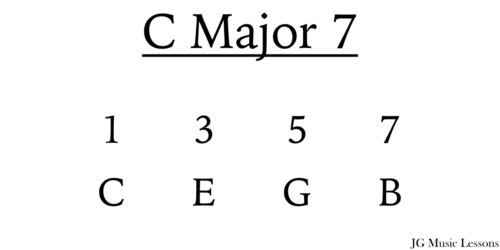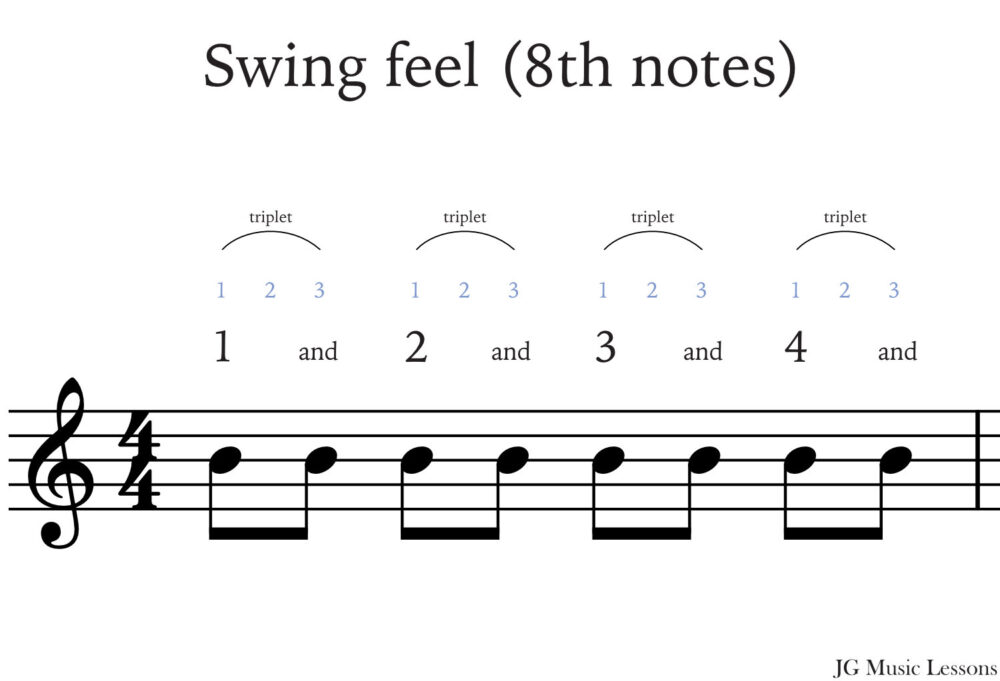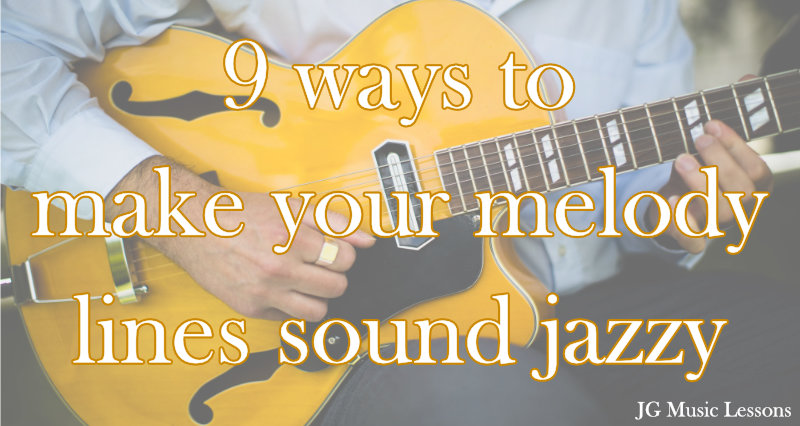Have you tried sounding more jazzy on your instrument, but weren’t sure on how to go about this? Although jazz is a whole musical language of its own, we can take away some key concepts that will give more depth and character to your musical ideas.
To clarify, a “line” simply means a series of notes which can be played over a chord or series of chords when writing a melody or when improvising.
We’ll be extracting different concepts used in jazz by learning melody/lines with tabs and audio to help you play the examples. This will also help you improve your improvisation skills and give you some ideas to explore on your instrument.
The 9 concepts we’ll be covering are:
- Playing with swing feel
- Using chord tones
- Playing over the bar line by anticipating notes
- Using the bebop scale
- Using chromatic notes
- Using approach notes
- Using triplets
- Using articulations (i.e. slides, staccato notes)
- Transcribing
The following examples are based on playing over a Major 7 chord. Skip here if you already know what a Major 7 chord is.
What is a Major 7 chord?
A Major 7 chord has the chord tones 1, 3, 5, and 7. Chord tones are the notes that outline the structure and quality of a chord. You can think of these chord tones as the scale degrees which come from the Major scale. Major 7th chords are frequently heard in jazz and r&b styles of music.
In this lesson, we will only focus on playing over a C Major 7 chord which has the notes C, E, G, and B.

To learn how to play this chord, check out 7 ways to play a C Major 7 chord on guitar.
Here is how you can play a C Major 7 arpeggio on the guitar in two octaves. (Check the numbers above the notes to help your fingering on the fretting hand.)

You can check out this other lesson to learn how to play Major 7 arpeggios on guitar.
1. Playing with swing feel
One of the biggest characteristics of jazz is the feel of the rhythm. We usually think of eight notes as equally spaced out and divided in between strong beats (meaning beats 1, 2, 3, 4). But in jazz, the eight notes in between strong beats are slightly delayed which creates the ‘swing’ feel.
In contrast, we would call equally divided beats as ‘straight time’. This straight time is what we are used to hearing in modern pop and rock music so it may take some time get used to a swing feel if you aren’t familiar with it.
You can think about 8th notes in swing feel as the first and last notes of 8th note triplets like this:

Try counting triplets out load as ‘1, 2, 3’ repeatedly but emphasize the 1 and 3. This is would give you the effect of swing 8th notes where your 1 is a strong beat and 3 is the eight note in between a strong beat.
As you can see, the eight notes in between strong beats are slightly delayed as opposed to being equally divided between strong beats. Check out this first example to hear what this rhythm sounds like.

2. Use chord tones
Just like I explained earlier how the C Major chord has 4 chord tones (C, E, G, B, you can use notes these to create a melody line.
Of course, feel free to add other scale notes, but using these chord tones will outline the structure of the chord you are playing over. You will often hear jazz musicians play chord tones to outline the chord changes of a song which helps to guide and keep the listener engaged if done correctly.
Once you know what the chord tones are, you want develop your lines to be melodically and rhythmically interesting. Chord tones can be played over any chord and the notes are different according to the chord quality, meaning whether a chord is Major, minor, or diminished.

3. Play over the bar line by anticipating notes
Anticipating notes over the bar line (meaning the next measure) is another characteristic sound used in jazz. You will often hear notes on the ‘and’ of beat 4 to anticipate a note on the next measure. These kind of rhythms create a kind of motion which can make lines sound more exciting and lively or as jazzers would say ‘swing harder’.
Take a look at how this following example uses the anticipated notes on the ‘and’ of beat 4.

4. Using the bebop scale
Bebop refers to the jazz era characterized by players like Charlie Parker, Dizzy Gillespie, Miles Davis and Thelonious Monk. There is a kind of musical vocabulary that emerged from this era but it continues to be used and developed in modern jazz.
Over Major chords, a bebop scale includes a chromatic note between the 5th and 6th degree so when you play the scale, you end up playing chord tones on the strong beats of a measure. This is also referred to as the Barry Harris Major 6th diminished scale (see the lesson here).
For example, a C Major bebop scale would be: C, D, E, F, G, Ab, A, B.
Here is an example of how you can use this scale:

Note that there are also other bebop scales that can be played over minor 7, dominant 7 or half diminished chords.
5. Using chromatic notes
Just as we added a chromatic note in the previous bebop scale example, we can also add other chromatic notes between scale notes to add tension and interest in a melody/line.
Again, you will often hear the chromatic notes in between strong beats so that you end up playing chord tones on the strong beats.
Check out this example to hear how a chromatic note is being used in measure 2:

6. Using approach notes
There are many ways you can approach certain notes of scale, either from above, below or both. In the example below, the third note (Db) in measure 1 would likely go to C, but you can also add a B from below, which is what we see happening. This can be called an enclosure, where you’re wrapping around a certain note before playing it. The C can be seen as a target note in this case and the notes before it are the approach notes.
You will also see approach notes before the B note in measure 2, beat 3. You have a C then a Bb before you land on that B note.
Approach notes can from diatonic notes (notes from the scale) or chromatic notes (a half step above or below, not necessarily from the scale).
Check out the following example to hear what this sounds like:

7. Using triplets
Using triplets is another characteristic rhythm often heard in jazz. These triplets are often played as arpeggios to outline a chord and create interesting rhythms throughout a line.
See how triplets are being used in the following example to make up the line.

8. Using articulations (i.e. slides, staccato notes)
Articulations mean the different ways you can play a note, whether that’s hammer on, pull offs, staccato, slides, depending what is possible on your instrument of course.
Articulations add expression and character to the way you play notes. Just like every genre has it particular expressions, we want to do the same in jazz. By listening to the great artists that paved the way for this style of music, we can gain insight on how the music can best be expressed.
See how certain notes are played in this following example to show you what I mean. (The first note would be a slide on guitar, but expresesed as a grace note on piano). The dots above some notes represent staccato notes, which means they are shortened.

Check out this post to learn more music symbols.
9. Transcribe, transcribe, transcribe
If you’re not familiar with transcribing, it simply means to write down what you hear. We do this to learn and analyze the music that you enjoy by writing it down as you listen. If you’ve never done this, start with something very simple and try writing down a few notes and gradually progress to learning entire solos or chord progressions.
For example, you could use the My Music Composition Notebook to collect your musical ideas, polish your notation skills, or transcribe a cool solo. For a more in depth understanding of how to transcribe, check out this post on how to develop ear training.
Jazz is a language with it own musical vocabulary so transcribing will help you to understand the way phrases should sound. You really need to soak in the music by listening to different examples of artists or albums that you like in this style. The more you transcribe, the more natural your lines start to sound.
I also recommend transcribing different instruments so that you can learn other ways of playing melodies, phrases or solos that may not be often played on your particular instrument. Some shapes and patterns may be convenient for your instrument so it can be refreshing to try learning something that sounds different than what you are used to.
Wrapping up
We looked at 9 different ways to make your melody lines sound jazzy by exploring rhythm, harmony, theory and ear training. Use the musical concepts we covered here to explore new ideas on your instrument.
Since we played these examples over a Major 7 chord, you might also want to check out these 7 jazz and blues licks over a Dominant 7 chord.
To enhance your melodies and lines for improvisation, check out other scales such as the blues scale, pentatonic scale, or the diminished scale.
Get the free practice guide here!
All the best,
JG Music Lessons
Photo by Jonathan Farber on Unsplash
📙 Kickstart your guitar playing with our step by step guide: Guitar Essentials.
🎸 Looking for a travel or half-sized guitar? See this one.
🛠 See our other music recommendations.
🤝 Support the site to help us to create better content for you!
Level up with the FREE guitar practice guide and effectively improve your playing! 🎸
Get it sent to your email!



